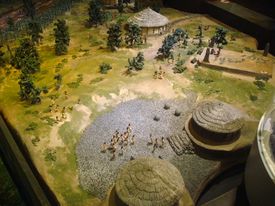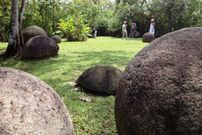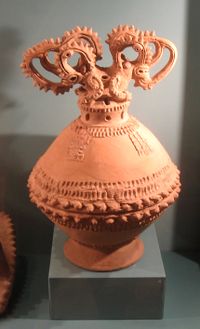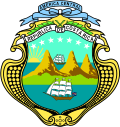تاريخ كوستاريكا
The first indigenous peoples of Costa Rica were hunters and gatherers, and when the Spanish conquerors arrived, Costa Rica was divided in two distinct cultural areas due to its geographical location in the Intermediate Area, between Mesoamerican and the Andean cultures, with influences of both cultures.[1][2]
Christopher Columbus first dropped anchor in Costa Rica in 1502 at Isla Uvita. Soon after, his forces overcame the indigenous people. He incorporated the territory into the Captaincy General of Guatemala as a province of New Spain in 1524. For the next 300 years, Costa Rica was a colony of Spain. As a result, Costa Rica's culture has been greatly influenced by the culture of Spain.[3] During this period, Costa Rica remained sparsely developed and impoverished.
Following the Mexican War of Independence (1810–1821), Costa Rica became part of the independent Mexican Empire in 1821. Costa Rica was part of the Federal Republic of Central America in 1813, before gaining full independence in 1821. Its economy struggled due to lack of connections with European suppliers. In 1856, Costa Rica resisted United States settlers from mounting a take-over of the government.
بعد 1869، أسست كوستاريكا حكومة ديمقراطية.[3]
After the Costa Rican Civil War in 1948, the government drafted a new constitution, guaranteeing universal suffrage and the dismantling of the military. Today, Costa Rica is a democracy that relies on technology and eco-tourism for its economy. Although poverty has declined since the turn of the 21st century, economic problems still exist. Costa Rica is facing problems of underemployment, foreign and internal debt, and a trade deficiency.[3]
الصيادون-الجماعون
The oldest evidence of human occupation in Costa Rica is associated with the arrival of groups of hunter-gatherers about 10,000 to 7,000 years BC, with ancient archaeological evidence (stone tool making) located in the Turrialba Valley, at sites called Guardiria and Florence, with matching quarry and workshop areas with presence of type clovis spearheads and South American inspired arrows. All this suggests the possibility that in this area two different cultures coexisted.
The people of this era were nomadic. They were organized in family-based bands of about 20 to 30 members. Their usual prey animals were called megafauna, such as giant armadillos and sloths, mastodons, etc. These became extinct about 8,000 years before the modern era. The first settlers had to adapt to hunting smaller animals and develop appropriate strategies to adjust to the new conditions.
كوستاريكا قبل كلومبس
In Pre-Columbian times, the native peoples in what is now Costa Rica were divided in two cultural areas due to its geographical location in the Intermediate Area, between the Mesoamerican and the Andean cultural regions.[1][2]
The northwest of the country, the Nicoya Peninsula, was the southernmost point of Mesoamerican cultural influence when the Spanish conquerors came in the sixteenth century. The Nicoya culture was the largest cacicazgo on the Pacific coast of Costa Rica.[1] The central and southern portions of the country belonged to the Isthmo-Colombian cultural area with strong Muisca influences, as these were part of territories occupied predominantly by speakers of the Chibchan languages.[2][4] The Diquis culture flourished from 700 CE to 1530 CE and were well known for their crafts in metal and stonework.[5]
The indigenous people have influenced modern Costa Rican culture to a relatively small degree. In the years soon after European encounter, many of the people died due to infectious diseases, such as measles and smallpox, which were endemic among the Europeans but to which they had no immunity.[6]

الهنود هم أوائل الذين عاشوا فيما يُعرف الآن بكوستاريكا. ولا يُعرف إلا القليل عن حياة هؤلاء السكان. لكن مع بداية القرن الحادي عشر استقرت قبيلة كوروبيسي Corobicí في الوديان الشمالية، بينما هاجرت قبيلة بوريكا Burica إلى الأراضي الواقعة في الجنوب. وصل هنود الكاريب وشوروتگا Chorotega وناهوا Nahua في القرن الخامس عشر. وكان معظم الهنود يعيشون على زراعة المحاصيل وصيد الحيوانات الصغيرة.
الاستعمار الاسباني
وصل كريستوفر كولمبوس إلى كوستاريكا في عام 1502. وقد أغرت الشائعات التي راجت عن وجود الذهب في المنطقة مئات الأسبان للذهاب إلى الأرض الجديدة.
عثر الأسبانيون على قليل من الثروات المعدنية. ولكن العديد منهم أقاموا وأصبحوا مزارعين في المرتفعات الوسطى. وأقام الحاكم خوان ڤاسكويز دي كورونادو أول مستوطنة دائمة في كارتاگو في عام 1564م. حاول كثير من الأسبان استرقاق الهنود، ولكن معظم القبائل حاربت بشراسة لكي تحافظ على حريتها.
الاستقلال عن اسبانيا
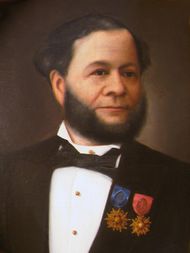
In the early 19th century, Napoleon's occupation of Spain led to the outbreak of revolts all across Spanish America. In New Spain, all of the fighting by those seeking independence was done in the center of that area from 1810 to 1821, what today is central Mexico. Once the Viceroy was defeated in the capital city—today Mexico City—in 1821, the news of independence was sent to all the territories of New Spain, including the Intendencies of the former Captaincy General of Guatemala. Costa Rica joined the other Central American Intendancies in a joint declaration of independence from Spain, the 1821 Act of Independence.
On October 13, 1821 the documents arrived at Cartago, and an emergency meeting was called upon by Governor Juan Manuel de Cañas. There were many ideas on what to do upon gaining independence, such as joining Mexico, joining Guatemala or Nueva Granada (today Colombia). A group was declared (Junta de Legados), which created the temporary Junta Superior Gubernativa de Costa Rica. Meanwhile, "the clouds clear up" ("Mientras se aclaraban los nublados del día"), was a famous phrase of the events of the day.
Independence from Spain was acknowledged and ratified on October 29, 1821 by the colonial authorities. It was then ratified in the cities of San José on November 1, 1821, at Cartago on November 3rd, 1821, at Heredia on November 11, 1821, and Alajuela on November 25, 1821.[7]
After the declaration of independence, the New Spain parliament intended to establish a commonwealth whereby the King of Spain, Ferdinand VII, would also be Emperor of New Spain, but in which both countries were to be governed by separate laws and with their own legislative offices. Should the king refuse the position, the law provided for a member of the House of Bourbon to accede to the New Spain throne. Ferdinand VII did not recognize the colony's independence and said that Spain would not allow any other European prince to take the throne of New Spain.
By request of Parliament, the president of the regency, Agustín de Iturbide, was proclaimed emperor of New Spain, which was renamed Mexico. The Mexican Empire was the official name given to this monarchical regime from 1821 to 1823. The territory of the Mexican Empire included the continental intendancies and provinces of New Spain proper (including those of the former Captaincy General of Guatemala) (See: History of Central America). On 5 April 1823 the Battle of Ochomogo was fought between forces from Cartago who wanted to join the Mexican Empire and those who preferred to remain independent. The Republicans won and the capital was moved from Cartago to San José.
الجمهورية الاتحادية في أمريكا الوسطى

بقيت كوستاريكا مستعمرة أسبانية حتى 1821. وفي ذلك العام تحررت كوستا ريكا والمستعمرات الأسبانية الأخرى في أمريكا الوسطى من الحكم الأسباني، ثم انضمت إلى الإمبراطورية المكسيكية في العام التالي في عهد أگوستين ده إيتوربيده. وفي عام 1823 انسحبت دول أمريكا اللاتينية من المكسيك وانضمت كولاية في جمهورية أمريكا الوسطى الفدرالية. وانتقلت العاصمة في 1824 إلى سان خوزيه بعد منافسة دموية مع كرتاگو. وبدأ الاتحاد في الانهيار في عام 1838 وأعلنت كوستاريكا استقلالها.
في عام 1842 أطاح فرانسيسكو مورازان بالحكم الدكتاتوري للرئيس براوليو كاريلو وأصبح رئيسًا للبلاد. وحاول مورازان إحياء الاتحاد، ولكن أعداءه قتلوه بعد تَوليه منصبه بخمسة أشهر. حَكَم البلاد زعماء ضعفاء حتى 1849م عندما بدأ خوان رفائيل مورا پوراس فترة عشر سنوات باعتباره رئيسًا. أسَّس مورا أول مصرف وطني في كوستاريكا، وأول شبكة إنارة للشوارع فيها، والعديد من المدارس العامة.
الجمهورية
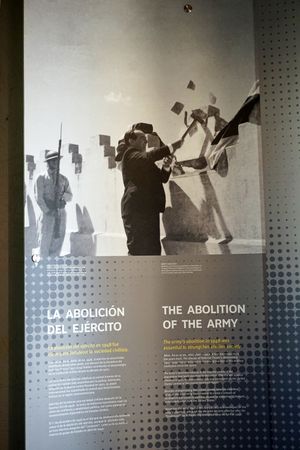
حدثت عدة ثورات في كوستاريكا منذ أواخر القرن التاسع عشر. فقد أطاح الجنرال توماس گارديا بالحكومة في 1870م، وحكم البلاد حكمًا مطلقًا لمدة 12 عامًا. وكان يشجع على الزراعة واسعة النطاق وعلى تصدير البن بوفرة. وقد أدخلت حكومته تحسينات على نظام مدارس الدولة، وبنت سكة حديدية من سان هوزيه حتى ليمون. وفي عام 1917 تولىّ فدريكو تينوكو گرانادوس الرئاسة. وأجبرته الاضطرابات السياسية على الاستقالة في عام 1919م، فتولىّ الزعامة جوليو أكوستا وأصبحت كوستاريكا تحت زعامة أكوستا وخلفائه نموذجًا للديمقراطية والإصلاح الاجتماعي.
في عام 1948 فاز اوتيليو أولاتي في انتخابات الرئاسة ولكن المجلس الوطني أعلن أن النتائج غير قانونية. بعد ذلك قاد العقيد خوزيه فيگويريز فرير تمرُّدًا تأييدًا لأولاتي للحيلولة دون ما قال عنه إنه تهديد بتولِّي الشيوعيين السلطة باعتباره رئيسًا مؤقتًا وأعاد تنظيم الحكومة، ووضع المصارف تحت السيطرة الاتحادية. كما استبدل بجيش كوستاريكا حرسًا وطنيًا تعداده 4,000 فرد، مع ضباط موالين له. وفي عام 1949م تم تنصيب أولاتي رئيسًا.
انتخب الكوستاريكيون فيگويريز رئيسًا في عام 1953م فرفع الحد الأدنى للأجور، ووسّع نظام المدارس الحكومية، وزاد الضريبة على الواردات. وفي عام 1955م قامت مجموعة من الكوستاريكيين في المنفى بتدبير غزو جوي وبري للبلاد من نيكاراگوا. وحاول الثوار قلب حكومة فيگويريز ولكنهم مالبثوا أن أحبطت محاولتهم. وسعى الرئيس ماريو إيشاندي الذي تولى الرئاسة من 1958م حتى 1962م إلى التخفيف من سيطرة الحكومة على الاقتصاد. ولكن الجمعية التشريعية اعترضت على العديد من مقترحاته. وفي عام 1962م تم انتخاب فرانسيسكو ج. أورلتش رئيسًا.
ومما يذكر أنه فيما بين عامي 1963م و 1965م ثار بركان إيرازو وأمطر سان هوزيه والمناطق المحيطة بها بوابل من الرماد. وتسبب ثوران البركان في إتلاف محصول البن واضطر آلاف السكان إلى هجر بيوتهم.
التطورات الحديثة. فاز فيگويريز بالرئاسة من جديد في عام 1970م، حيث خلف خوزيه خواكين توريهوس-فرنانديز ـ وتقاعد فيجويريز في 1974م، ثم توالت على كوستاريكا سلسلة من الحكومات الديمقراطية. وعمل الرؤساء الكوستاريكيون على المحافظة على الحياد التقليدي في القضايا الدولية في الوقت الذي حافظوا فيه على علاقات طيبة مع الولايات المتحدة الأمريكية.
بدأ اقتصاد كوستاريكا في أوائل الثمانينيات في الانحدار. وكان من بين المشاكل الاقتصادية في البلاد ارتفاع معدل البطالة، وانخفاض عائدات الصادرات، وارتفاع الديون الأجنبية. وزادت الولايات المتحدة من مساعداتها المالية لكوستاريكا لمعالجة المشاكل. وفي نهاية الثمانينيات خَفَّضتَ كوستاريكا نسبة البطالة إلى 4,5%، وهي أقل نسبة في منتصف الكرة الأرضية. وأقامت شركات متعددة الجنسيات من دول كثيرة واقعة عبر البحار مشاريع تجارية وصناعية هناك.
أدّى اوسكار أرياس سانشيز الذي كان رئيس كوستاريكا منذ عام 1986م وحتى 1990م دورًا قياديًا في إيجاد خطة سلام إقليمية لأمريكا الوسطى. وفاز في عام 1987 بجائزة نوبل للسلام اعترافًا بجهوده[8]
الديمقراطية
انظر أيضاً
عام:
المصادر
- ^ أ ب ت Greater Nicoya Culture - Precolumbian culture of Costa Rica and Nicaragua Nicoya
- ^ أ ب ت Hoopes, John W.; Oscar Fonseca Z. (2003). Goldwork and Chibchan Identity:Endogenous Change and Diffuse Unity in the Isthmo-Colombian Area (PDF). Washington, DC: Dumbarton Oaks. ISBN 0-82631-000-1. Archived from the original (Online text reproduction) on 2009-02-25.
- ^ أ ب ت "Costa Rica." Funk & Wagnalls New World Encyclopedia (2014): 1p. 1.; accessed 19 February 2015.
- ^ Quilter, Jeffrey and John W. Hoopes, editors (2003). Gold and Power in Ancient Costa Rica, Panama, and Colombia. Washington, DC: Dumbarton Oaks. ISBN 0-88402-294-3. Archived from the original (Online text reproduction) on 2019-03-27. Retrieved 2019-09-08.
{{cite book}}:|author=has generic name (help)CS1 maint: multiple names: authors list (link) - ^ "Diquís". Museo Chileno de Arte Precolombino. Retrieved 25 March 2012.
- ^ The Story Of... Smallpox
- ^ Mi Patria, Fascículo #5, "Acta de la Independencia de Costa Rica", La Nación, September 4, 2013
- ^ كوستاريكا في االموسوعة المعرفية الشاملة.

